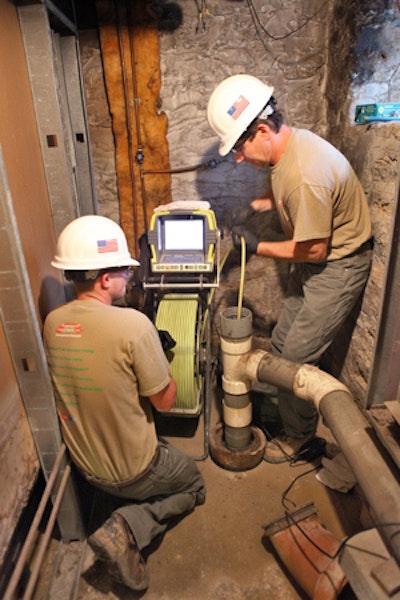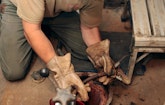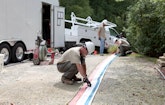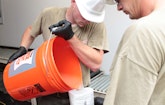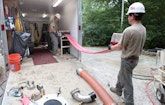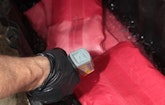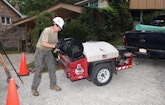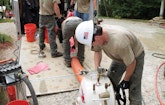
Interested in Relining/Rehab?
Get Relining/Rehab articles, news and videos right in your inbox! Sign up now.
Relining/Rehab + Get AlertsCharles Menkhaus was dealing with declining business when he decided to make the significant investment to get into cured-in-place pipe lining. It was a move that would pay big dividends and ultimately help his business grow once again.
As owner of C.M.E. Services in Cincinnati, Ohio, Menkhaus had spent 10 years repairing and replacing pipes for local plumbers and builders, and he knew his customers were looking for alternatives to digging and replacing pipes.
Menkhaus did some research and eventually settled on the Perma-Liner Industries lining system after visiting the company’s Florida facility. Once he jumped on board, the company sent two representatives to help Menkhaus and his technicians learn the system.
“I actually paid for extra help with the training,” Menkhaus says. “We spent an entire week with two days in the shop, and we completed three jobs. It was pretty brutal. I wanted to get as much done as possible to be sure everyone was properly trained and got all the hands-on experience they needed.”
He and six employees went through the training process and learned how to install the liners, despite difficult weather conditions.
“We had horrible snowstorms, but with this system, you can work in cold weather. The temperature was never above 20 degrees. We use the hot-water cure system, and the cold really didn’t affect the curing time or anything else.”
Within six months, Menkhaus had a crew of four dedicated strictly to pipe lining and was looking to hire at least three more technicians for a second crew. Demand quickly grew from three or four liners per week to five and six per week. Lining now makes up 80 percent of the company’s sewer replacement work.
All the proper tools
To support his lining services using the Perma-Liner Maverick hot-water cure system, Menkhaus includes locating, TV inspection and root removal for his customers. He chose the VuTEK GT series push camera from Insight Vision with 200 feet of cable, color self-leveling camera head, USB thumb drive recording and a 512 Hz sonde. For mainline inspections, the company can subcontract for a pan-and-tilt camera.
The locator is a Model 8872 from Rycom Instruments. Menkhaus also has a Model 1065 sewer machine and a Model 738 trailer jetter (2,500 psi/14 gpm), both from Spartan Tool.
The pride of the fleet is a 2011 Ford F-550 service truck dedicated to lining. C.M.E. also owns a 2001 Ford dump truck, a 2005 International 5-ton dump truck, a 2010 Takeuchi crawler-based mini excavator, and a Caterpillar track loader.
C.M.E. Services travels in a 25-mile radius and operates out of a 4,000-square-foot facility in an industrial park in Cincinnati. The firm also does some work across the Ohio River in Kentucky.
Because C.M.E. is always a subcontractor, there is no lettering or logo on its equipment.
“I like the niche I am in,” says Menkhaus. “I don’t have to go sell the job. I don’t have to spend money on advertising. My customer tells me where the job is and how long the liner is, and we take it pretty much from there.”
Conditions on the ground
C.M.E. deals mainly with three types of pipe – mostly vitrified clay, along with some concrete and cast iron. Pipes are often buried in 10 to 12 feet of clay soil with glaciated rock and sand that can be loose and gritty.
“The soil is considered the worst for excavation, as it is rated at a Class C,” Menkhaus says. “Sometimes the pipe can be buried as deep as 15 to 20 feet, depending on the topography. That can be dangerous when replacing a line, and we have to use trench boxes and other safety measures when a hole is opened up.”
Root intrusion is generally the issue in pipes installed prior to 1980. Concrete pipe, because of its weight, was installed in 3- to 5-foot sections, leaving multiple joints where maple and oak roots can work their way in.
“We also see cast-iron pipe rotting out on the bottom because of the constant flow of sewage,” Menkhaus says. “You run a camera and see the grooves. Sometimes the camera gets stuck and we have to pull it out because the pipe is just rotten.”
Clay pipes present two problems for C.M.E. crews. The first is root intrusion. The second is the soil in which the pipe is buried.
“When the ground dries up and shifts and then gets wet and heavy, the clay doesn’t have the strength of other pipes, and it shatters, cracks, and starts to fall apart,” Menkhaus says.
All these pipes are suitable for relining if they have not completely collapsed. Small sections frequently require spot repair, after which the entire pipe can be lined. Menkhaus likes the hot-water cure system because he finds it is easy to use, involves no downtime, and is compact and easily transported.
The game plan
Jobs for C.M.E. often arise out of emergencies: A homeowner calls a plumber after discovering a toilet backed up, a tub that won’t drain, or water in the basement.
“The plumbing company most often calls us if they think a liner would be a solution,” Menkhaus says. “They put their camera in and determine the length of the pipe and whether it can be lined. We are on the telephone with them while they are at the site. From there, we work hand in hand.”
Plumbers on a potential lining site can reach Menkhaus by cell phone for help determining the viability of lining. For example, if there is an offset or a line has collapsed and a plumber wants an immediate answer, the person doing the inspection can take a photo of the inspection camera monitor screen and send it sent to Menkhaus for a verdict.
“I am on the telephone every day with six or seven plumbers who are out selling liners, and they want an answer,” Menkhaus says. “Frequently we will get all the information one day and begin preparation on a job the next day.”
Accurately assessing pipe size is critical. Most laterals are 4-inch or 6-inch lines, but there are some 5-inch lines. Menkhaus keeps an extensive inventory of liner sizes to meet his customers’ needs.
Step by step
Crews complete jobs in a two-day process. Day one is for preparation, which can take up to four hours. The first step is at the cleanout in the basement or slab floor of the house, where workers cut out a 2- by 3-foot section of the concrete and dig down to expose the line. They remove a section of the pipe along with the cleanout, and use a jetter and cables to clean the line.
They inspect the line with a push camera and take the necessary measurements, then replace the missing section of pipe using flexible pipe connectors by Fernco. A piece of plywood is placed over the opening for safety and to allow the customer to use the facilities overnight.
Workers return the next day to do the lining. They remove the flexible connector, inspect the line again and cap the house side of the sewer. Then they deploy the Perma-Verter inverter, which is made of aluminum and is easily transported. Working in the dedicated liner truck, they take final measurements, mix the resins, prepare the liner and shoot it into the line.
Prepared for any task
Typically, the pipe under the house transitions from 4 to 6 inches in diameter about three to 10 feet from the house. Perma-Liner makes a transitional liner that takes care of both diameters, creating a tapered transition that leaves no sharp edges.
Menkhaus keeps liners for this purpose in inventory, but if need be, he can order the custom product from Perma-Liner and get fast turnaround. The liner must be carefully measured and cut from each end to achieve a proper fit. Before the installation, technicians use a permanent marker to record the date and the address on the liner.
Offering CIPP and related services has opened a new avenue for C.M.E. Services. Menkhaus’ top priority is to respect owners’ property and make sure they are happy with the final product.
“It’s not how fast we do the job,” he says, “but that it’s done correctly.”
